OTD in early British television: 5 May 1938
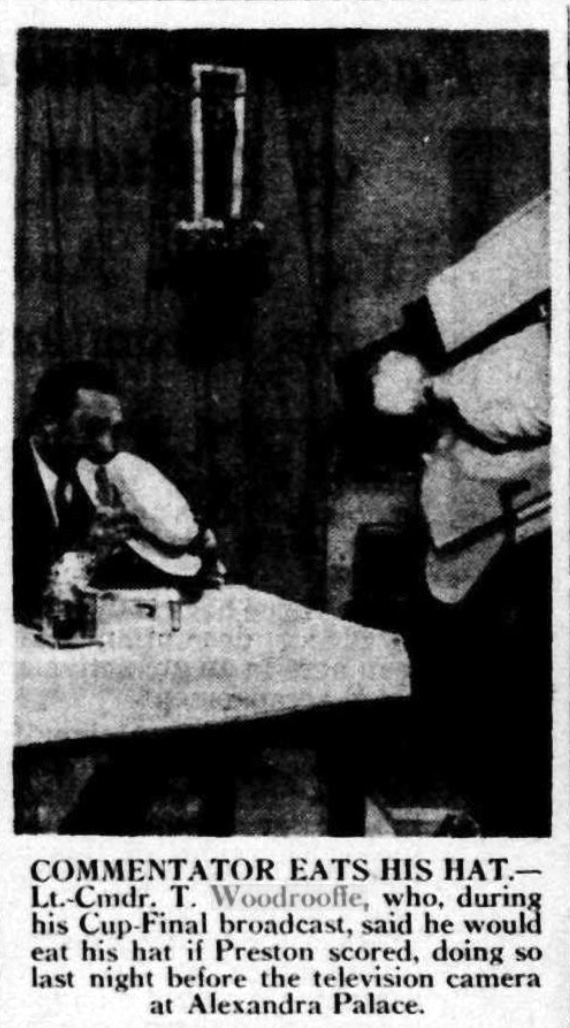
Daily Telegraph, 6 May 1938, with a picture (and apologies for the quality of the reproduction) taken in the studio during the previous evening’s Picture Page.

Daily Telegraph, 6 May 1938, with a picture (and apologies for the quality of the reproduction) taken in the studio during the previous evening’s Picture Page.
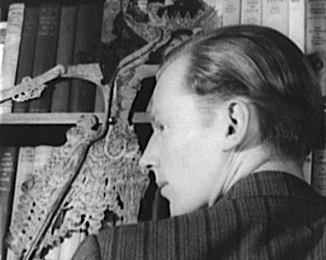
John Wyver writes: Yet more dance from Alexandra Palace, this time on the evening of Thursday 4 May 1939. Which only speaks to how rich and varied was early television’s presentation of the artform. Alongside actors Janine Darcey and Jim Gerald, and Norwegian newspaperman Haakon Overland, the 240th edition of Picture Page featured ‘famous tap dancer’ Paul Draper (above, in a detail from a Carl van Vetchen portrait), who was appearing at the Café de Paris.
Draper was celebrated for combining tap dancing with classical music, and here he performed to a Toccata by Paradisi and Gavotte from the opera Mignon by Ambroise Thomas, alongside more familiar tunes like ‘Merrily We Roll Along’ and ‘Yankee Doodle’.
read more »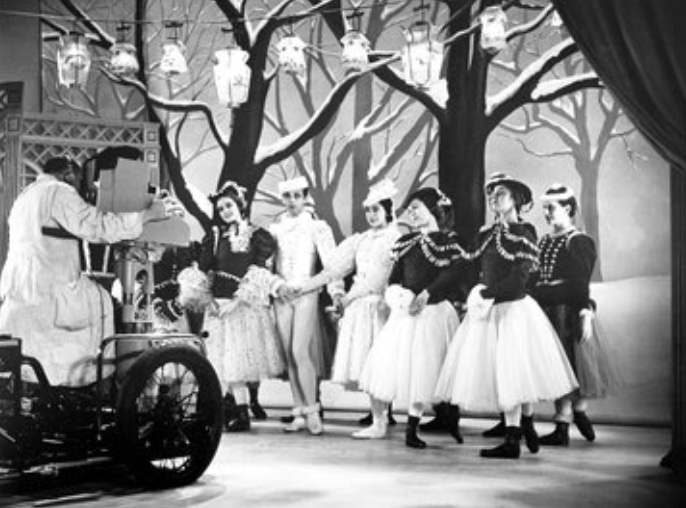
John Wyver writes: More or less six months to the day after the start of the ‘high definition’ television service from Alexandra Palace, on Monday 3 May 1937, members of the Vic-Wells ballet company travelled to the studio to perform, at 3.47pm and 9.47pm, Frederick Ashton‘s one-act ballet Les Patineurs (above).
The company had premiered what would become one of Ashton’s most popular ballets only in February at Sadler’s Wells. A cast of 15 dance a series of divertissements set at a Victorian skating party, conjured up by William Chappell‘s costumes and scenery. The idea had come from the Vic-Wells music director Constant Lambert, who created the score from fragments of two operas by Meyerbeer.
read more »
John Wyver writes: Ninety years ago tonight, on Thursday 2 May 1935, Ivor Novello‘s musical Glamorous Night premiered at the Theatre Royal, Drury Lane. The first nighters were enthralled and the box office registered exceptionally healthy sales. The show’s success led to the actor and composer beginning a series of lavish, operetta-style presentations, although this is the only one in which television has a central role.
Wikipedia has the basics about the show and its successors:
read more »For all his four 1930s musicals, Novello (above) wrote the book and music, Christopher Hassall wrote the lyrics, and the orchestrations were by Charles Prentice. Glamorous Night starred Novello and Mary Ellis, with a cast including Zena Dare, Olive Gilbert and Elizabeth Welch, and ran from 2 May 1935 to 18 July 1936, at Drury Lane and then the London Coliseum.
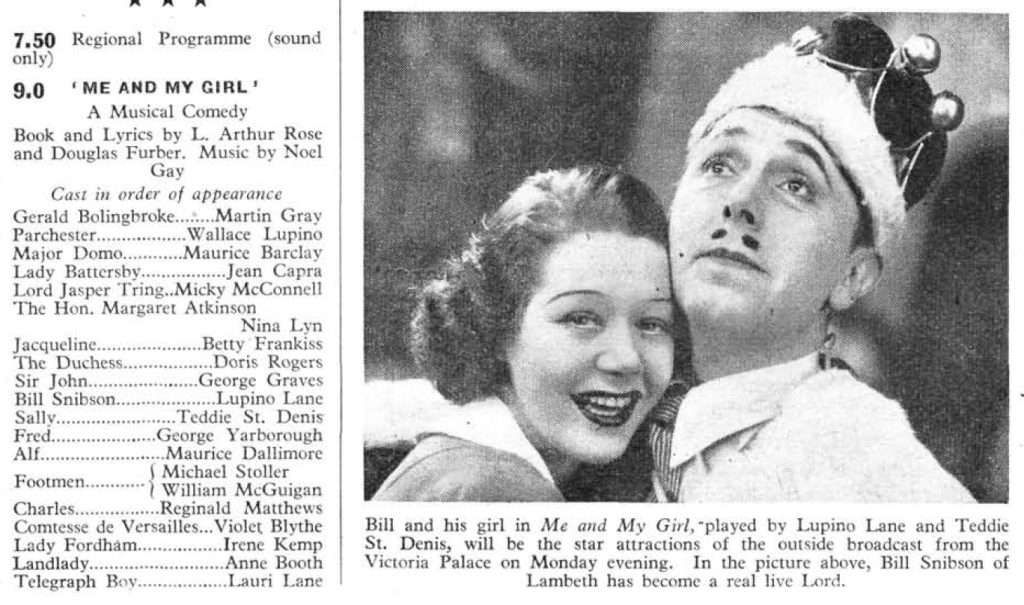
John Wyver writes: ‘One of the big television occasions of the year,’ was how Radio Times (above) trailed the live outside broadcast of the musical comedy Me and My Girl from the Victoria Palace on the evening of Monday 1 May 1939. This was the hugely successful ‘Lambeth Walk’ show starring Lupino Lane and Teddie St Denis, with music by Noel Gay, that had already been running for 18 months on stage. The broadcast went down so well that the television service did it all again on 17 July.
Television had first visited a West End theatre in November 1938 for J.B. Priestley’s When We Are Married, and then in March Magyar Melody had been broadcast in full. Having responded to both previous broadcasts, Grace Wyndham Goldie filed a further despatch for The Listener:
read more »I insist upon throwing a few bouquets… – to Mr. Lupino Lane, to the Me and My Girl company; to the television engineers; to Mr. Philip Dorté, who runs the outside broadcasts, and to the beneficent accident of fate which brought the King and Queen to Victoria Palace on the very evening when thousands of viewers were looking in.
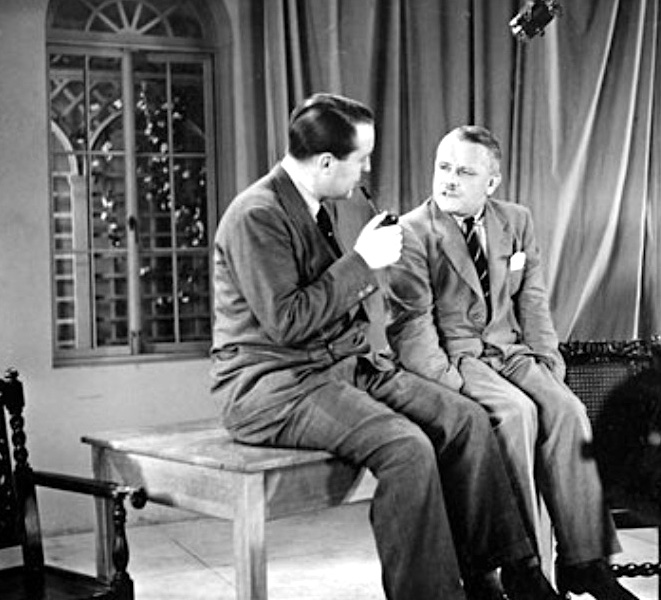
John Wyver writes: Sports punditry on television starts here, with the first edition of Sports Review on the afternoon and evening of Friday 30 April 1937. Billed as ‘a survey of the outstanding sports events in the month of April’, this first show in what was to become a monthly fixture was hosted by Leslie Mitchell, who spoke with a clutch of experts including Jack Petersen (British heavyweight champion) about boxing, Bernard Gadney (14 England caps) on ‘rugger’, Kingsley Kennerley on billiards, and Harold Abrahams (Olympic 100 metres gold medallist) on athletics.
The picture is in fact is from the second edition, looking back at sporting highlights in May, and shows as host Howard Marshall, who was slated to present the first edition too, with Mitchell stepping in at the last moment. Marshall, who was well-established as a radio commentator and who later broadcast from the Normandy’s D-day beaches , is speaking here with Captain H.B.T. (‘Teddy’) Wakelam, and the picture captures the casual, tweedy, bloke-y, pipe-smoking atmosphere that presumably characterised the programme.
Meanwhile, Mitchell and producer Royston Morley secured something of a scoop on the April afternoon, securing an interview with R.G. (‘Reg’) Rudd, who was to referee the next day’s FA Cup Final (Sunderland beat Preston North End 3-1), although in the evening soccer thoughts in a slightly shorter transmission were contributed by one ‘C. Murray’.
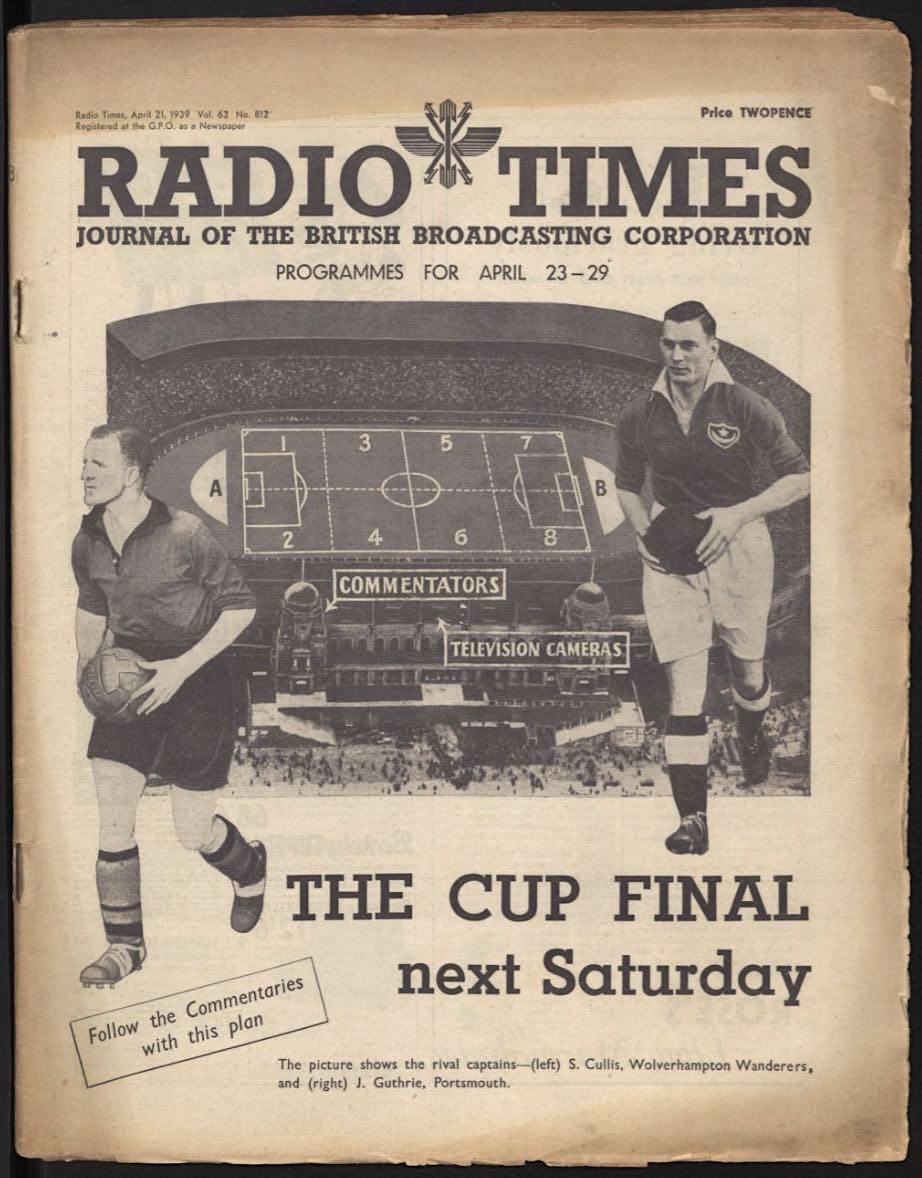
John Wyver writes: Saturday 29 April 1939 was some way off the heady days of my youth when FA Cup Final day was one of those rare and much-anticipated occasions when television began early on a Saturday morning. But already this was the medium’s third big match, starting at 2.40pm with community singing and the arrival of the King, and running through until closedown at 4.45pm.
Television this year earned a rare pre-war notice on the cover of Radio Times (above), with the position of the cameras pointed out in a helpful graphic that also included the ‘zonal’ marks of the 8 numbered areas of the pitch. These were to help listeners to the radio commentary to visualise the game, with one voice constantly noting which area the ball was in.
‘Two cameras will be installed just above the royal box,’ ‘The Scanner’ informed Radio Times readers, ‘and a third one well below it, on ground level. This trio should easily suffice to keep the whole of the game in the picture.’
read more »
John Wyver writes: The schedule from Alexandra Palace on Wednesday 28 April 1937 was unremarkable. As was the schedule two years later on Friday 28 April 1939. Which is more or less the point of this post, prompted in part by Billy Smart suggesting that I might write about the scheduling pattern of television in these years, and what changes – if any – this went through between 2 November 1936 and 1 September 1939.
This post can at least begin an outline, starting with a comparison of the hours of broadcasting. On both days television was transmitted in two main blocks, starting each day at 3pm and 9pm. The differences, however, included the additional transmission in 1939 of an hour in the morning so that television showrooms had something to demonstrate to potential customers.
There was no test card then, and so sales people showed potential customers The BBC Television Demonstration Film each day from 11am, followed by an edition of the soft-centred newsreel-type Ace Magazine film to make up an hour until midday.
Also in 1939, on the television wavelength the BBC had begun to broadcast selected elements of radio broadcasts prior to each block of television, so on 28 April 1939 users who had their television receivers switched on could hear The Daily Service from the National Programme at 10.15am, followed by an annoucnement relating to a speech by Adolf Hitler and then the weather forecast for farmers and shipping. At 8pm that evening the audio from the Regional Programme was carried, with a variety bill titled Ours is a Nice ‘Our, Ours Is.
read more »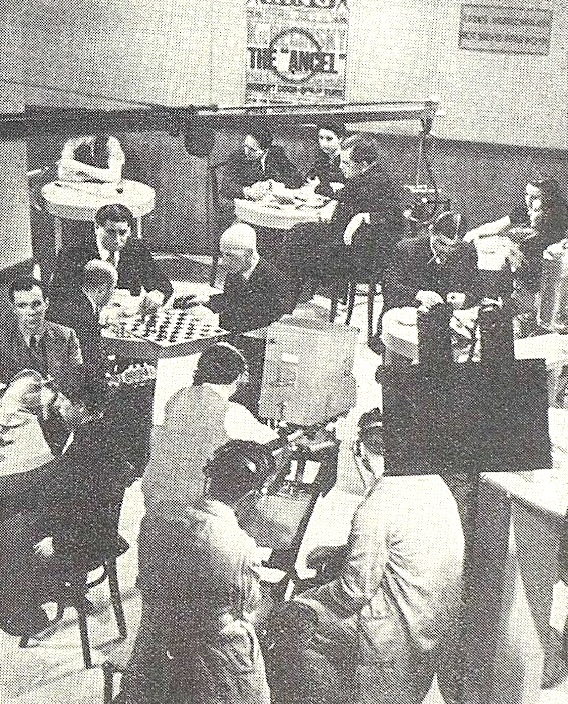
John Wyver writes: ‘There were three, large, hearty failures in the television programmes last week and I propose to discuss them.’ That was how the splendid television critic for The Listener, Grace Wyndham Goldie, began her 27 April 1939 column which was headed ‘Sad Trio’. And I propose to feature excerpts from her discussion to illustrate and celebrate her writing.
Yes, I know that any service must have failures and that television, being a new service, must have more failures than most. And I realise that Alexandra Palace turns out at least twenty-five productions a week and that three misses out of twenty-fiveshots isn’t bad marksmanship. Why, then, dwell on the three and ignore the remaining twenty-two?
Because the ways in which these programmes failed are of the utmost importance to listeners and it is most necessary that we should differentiate between them. Programme A was a valuable experiment and the sort of thing we welcome even at the cost of failure. Programme B promised to be good but it misfired because of the way in which it was presented. Programme C was an earnest piece of unmitigated boredom and had, as far as l could see, no justification of any kind whatever.
read more »
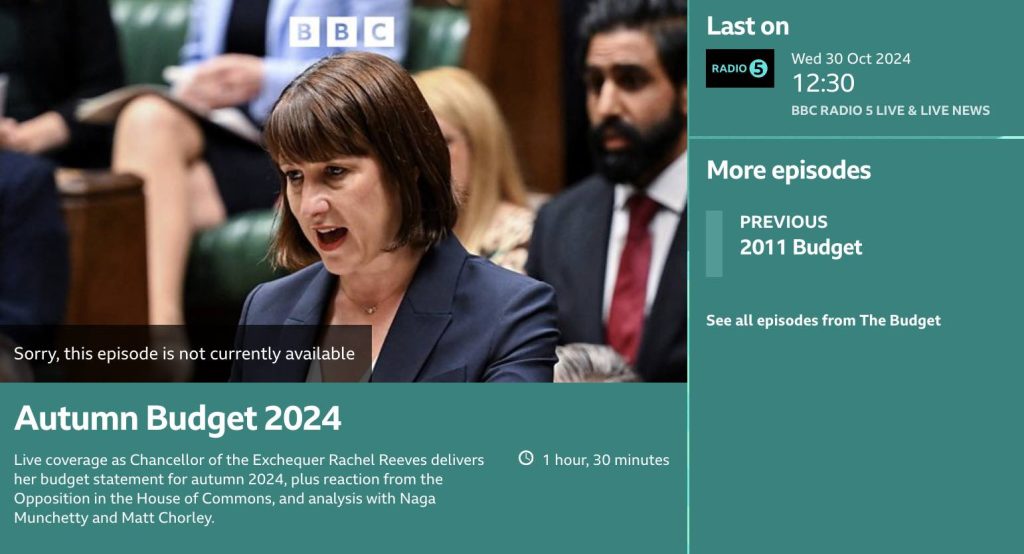
John Wyver writes: We take for granted live coverage and analysis of Budget speeches today, but television had to learn how to make such broadcasts, a process that began on Tuesday 26 April 1938. That evening from the studio at Alexandra Palace economist and tax expert Sir Josiah Stamp, G.C.B., G.C.E. (no, me neither) provided ‘an eyewitness account of the Budget speech’ given earlier that day by Chancellor of the Exchequer Sir John Simon.
This was preceded by a commentary from broadcaster (and noted marine biologist) Geoffrey Tandy accompanied by visuals valiantly compiled by Hannia Heyman (who appears to have left no other archival trace). Explaining that the year’s budget estimate was more than one billion pounds sterling, Tandy dug into the details. And mention of the time civil servants took to prepare the figures was paired with an image of a pile of Estimate Books.
read more »